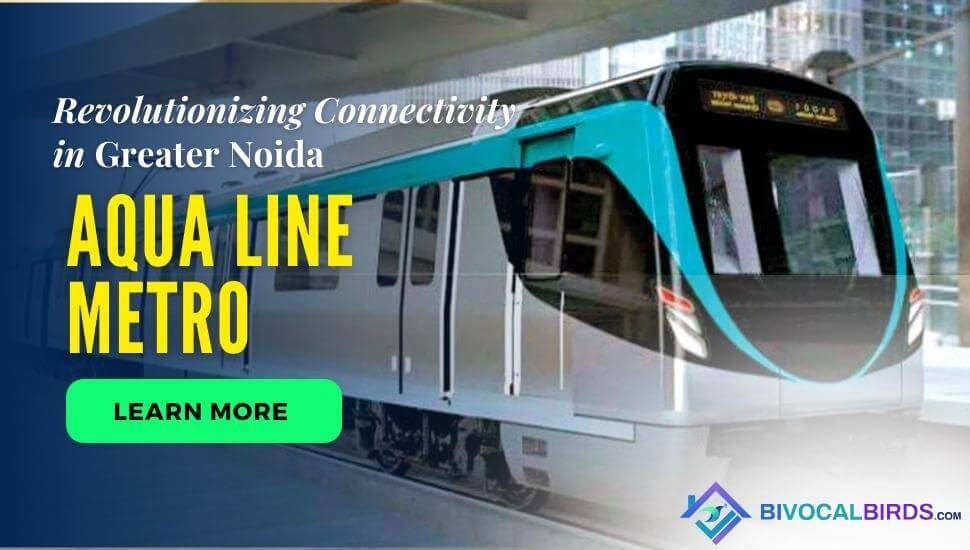The Aqua Line Metro: Revolutionizing Connectivity in Greater Noida
 19-Nov-2023
19-Nov-2023The launch of the Aqua Line Metro in January 2019 marked a significant milestone in Greater Noida’s transportation landscape. The metro has significantly enhanced regional connectivity and mobility by connecting Noida to Greater Noida for the first time via a high-speed rail network. Here is an in-depth look at how the metro has impacted the transportation ecosystem in Greater Noida.
Faster Connectivity with Delhi-NCR
The Aqua Line has dramatically reduced travel time between Greater Noida and Noida, Delhi and other parts of the NCR region. What took 2-3 hours by road earlier can now be reached in less than an hour. Greater Noida is now connected to the more prominent Delhi metro network via interchange stations at Sector 51, Sector 50, Sector 76 and Noida Electronic City metro stations. This seamless connectivity has made commuting faster, easier and more comfortable for residents. Metro travel time from Greater Noida West to Noida is 35 minutes compared to 90 minutes by road.
Greater Noida residents working in Delhi, Gurgaon, Faridabad and Ghaziabad have experienced significant relief thanks to direct metro access. Students can also take the metro to reach educational hubs like Manipal University, Shiv Nadar University and Galgotias University along the route. The metro has, therefore, achieved its core objective of integrating Greater Noida into the NCR transportation grid.
Also Read -
Improved Last-Mile Connectivity
One of the key advantages of the metro in Greater Noida is improved last-mile connectivity from stations to interior sectors. Earlier, the lack of efficient public transport caused hardship to residents. Now, the metro feeder buses and auto services, along with e-rickshaws and cycle sharing, pick commuters from their doorstep and drop them to the nearest metro station.
Dedicated feeder routes connecting large residential complexes to the Pari Chowk, Alpha 1, Delta 1, GNIDA Office and Depot metro stations have solved last-mile woes. Ridership has also increased owing to authorized e-rickshaws and bicycle stands at each station for completing journeys. Improving the last mile has thus encouraged the adoption of public transit.
Decongestion of Roads
Greater Noida has witnessed nearly a 35-40% drop in private vehicles on roads since the metro began operations. Thousands of commuters who used cars or bikes earlier now take the metro, helping decongest the roads. This has reduced noise and air pollution levels, making the city cleaner and more liveable. Traffic densities have declined at significant junctions like Pari Chowk, improving vehicular flow. Travel time by road has also reduced with less congestion.
According to traffic surveys, the vehicular pressure on prime Greater Noida-Noida routes has reduced by 27%. The metro has absorbed a significant chunk of road traffic, helping decongestion efforts. As connectivity improves, dependence on private transport is slated to decline further.
Also Read - Everything you need to know about Noida master plan 2031
Boost to Real Estate and Economic Activity
The metro has boosted real estate activity and economic growth around stations in Greater Noida. Due to improved connectivity to Noida and Delhi, property rates have surged by 15-25% along the metro corridor. Office spaces, malls and hotels are mushrooming around stations in Knowledge Park, Pari Chowk and Sector P2, taking advantage of high footfalls.
Affordable, Safe Public Transport Option
The metro has provided an affordable, safer public transport alternative to privately arranged cabs and autos for large sections. Daily office commuters, in particular, save significantly on transportation costs via metro access as the fares are only Rs. 20-50.
The metro is incredibly empowering for women professionals, students, and employed residents who faced issues of safety, commute reliability, and affordability earlier. Cleanliness, security and quality of metro operations have made it popular among regular commuters. It has shown the transformative impact reliable public transit can have.
Enhanced Multi-Modal Integration
The presence of metro stations near the key roads and bus junctions has enabled smooth multi-modal integration. Park-and-ride station facilities allow commuters to switch conveniently between metro, private vehicles, feeder buses and autos. Services like e-rickshaws and cycle sharing for the last mile also operate seamlessly with the metro.
Greater Noida and Yamuna Authority plan to connect metro stations with the proposed bus rapid transport system. This interoperability is helping enhance the metro’s reach and coverage across the city.
Also read - Why Greater Noida is the ideal Space home for families?
Limitations and Scope for Improvement
While the Aqua Line Metro has propelled Greater Noida’s connectivity, there is scope for improvement to unlock its full potential. Currently, the line connects only a limited section from the Depot station to Noida Sector 51. Extension to more areas is needed, as is integration with the upcoming Jewar Airport.
Feeder systems between stations and inner sectors need further streamlining through adequate vehicles and manpower. Parking lots near stations have to be expanded, and congestion managed. Safety mechanisms for women commuters also need augmentation.
More trains, integrated ticketing and intelligent signalling are vital in enhancing capacity, reducing wait times and improving the last mile. Behavioural nudges are also essential to make the metro indispensable to residents’ lives. Integrated town planning around transit hubs will maximize impact.
Wrapping up
Overall, the Aqua Line has significantly enhanced Greater Noida’s mobility and eased the commuting experience. It has laid the foundation for a sustainable transportation ecosystem driven by shared, clean public transit. Extensions to the line and feeder systems will exponentially multiply the metro’s connectivity potential. Greater Noida continues its journey to be a metro-enabled smart city.
For further information, You Can Call us or Email us on support@bivocalbirds.com.
Related Blogs:
- Noida-Greater Noida Rents Increase Up to 25% in One Year
- Find an Apartment That's Right for Your Lifestyle in Noida Extension in 2024
Best Location To Live In



